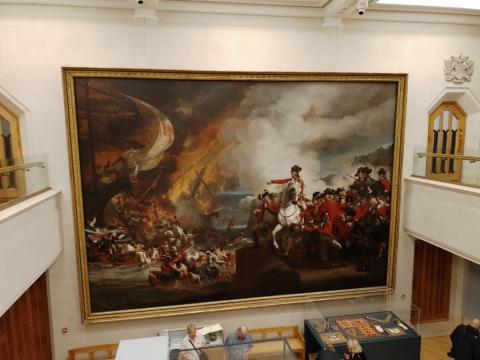Defeat of the Floating Batteries at Gibraltar (1783-91)

Defeat of the Floating Batteries at Gibraltar, 1782 by John Singleton Copley (1783-91) is a large oil on canvas. Commissioned in 1783, it enjoys pride of place at London’s Guildhall Gallery. Rather gigantic, it occupies an entire wall.
In September, 1782, Spain tried to conclude her long siege of Gibraltar with an attack from the sea, using ten specially-designed 'battering ships’, the so-called 'Floating Batteries'. On the morning of the 13th they moved into position and began a heavy artillery exchange as they tried to knock out the British gun emplacements. However, once the British (commanded by General Sir George Augustus Elliot, later Lord Heathfield) had heated up their shot to red-hot temperatures, the tide of the battle turned in their favour, with the Spanish Admiral's ship bursting into flames the following day. A British officer, Roger Curtis, set out with gunboats to pick up survivors, but two more ships exploded as fire reached their magazines. Despite the danger, Curtis and his men managed to rescue almost 350 people in all.
This is the scene depicted in the American-born John Singleton Copley's painting, commissioned by the City of London to honour the officers who had taken part. The Defeat was hung in 1795 in the Common Council Chamber, but was transferred in 1886 to the new Guildhall Art Gallery.
During the Second World War, the painting remained on display until April, 1941, when it was taken down and sent for safety to Swallowfield Park, near Reading - just three weeks before the gallery itself burnt down. Without a gallery there was nowhere to hang the picture, so it remained there until it was transferred to Newbury in 1947, and subsequently to commercial warehouse storage in London in 1961. Following the decision to re-build the gallery in 1984, remedial conservation work was undertaken. Having been hidden from view for fifty-eight years, Copley's masterpiece forms a magnificent backdrop to Guildhall Art Gallery's other paintings.
It seems ironic that a picture showing the burning up of Britain’s powerful enemies should nearly have been burned up itself by Britain’s powerful enemies. Thankfully, it was saved, but with only weeks to spare. The Bible, too, has many enemies: Eastern governments, Communist politburos, priests of false religions and the West’s energetic Equality Industry. Yet the good book speaks of their destruction. They might ban it and ridicule it, yet it is their own demise of which its pages so confidently speak.
Let the field be joyful, and all that is in it.
Then all the trees of the woods will rejoice
before the Lord.
For He is coming, for He is coming to judge the earth.
He shall judge the world with righteousness,
And the peoples with His truth.
Psalm 96:12-13, New King James Version
- Log in to post comments


 Sunday Worship 10.45am & 6.00pm
Sunday Worship 10.45am & 6.00pm